light CADILLAC SEVILLE 1996 4.G Owners Manual
[x] Cancel search | Manufacturer: CADILLAC, Model Year: 1996, Model line: SEVILLE, Model: CADILLAC SEVILLE 1996 4.GPages: 354, PDF Size: 20.21 MB
Page 6 of 354
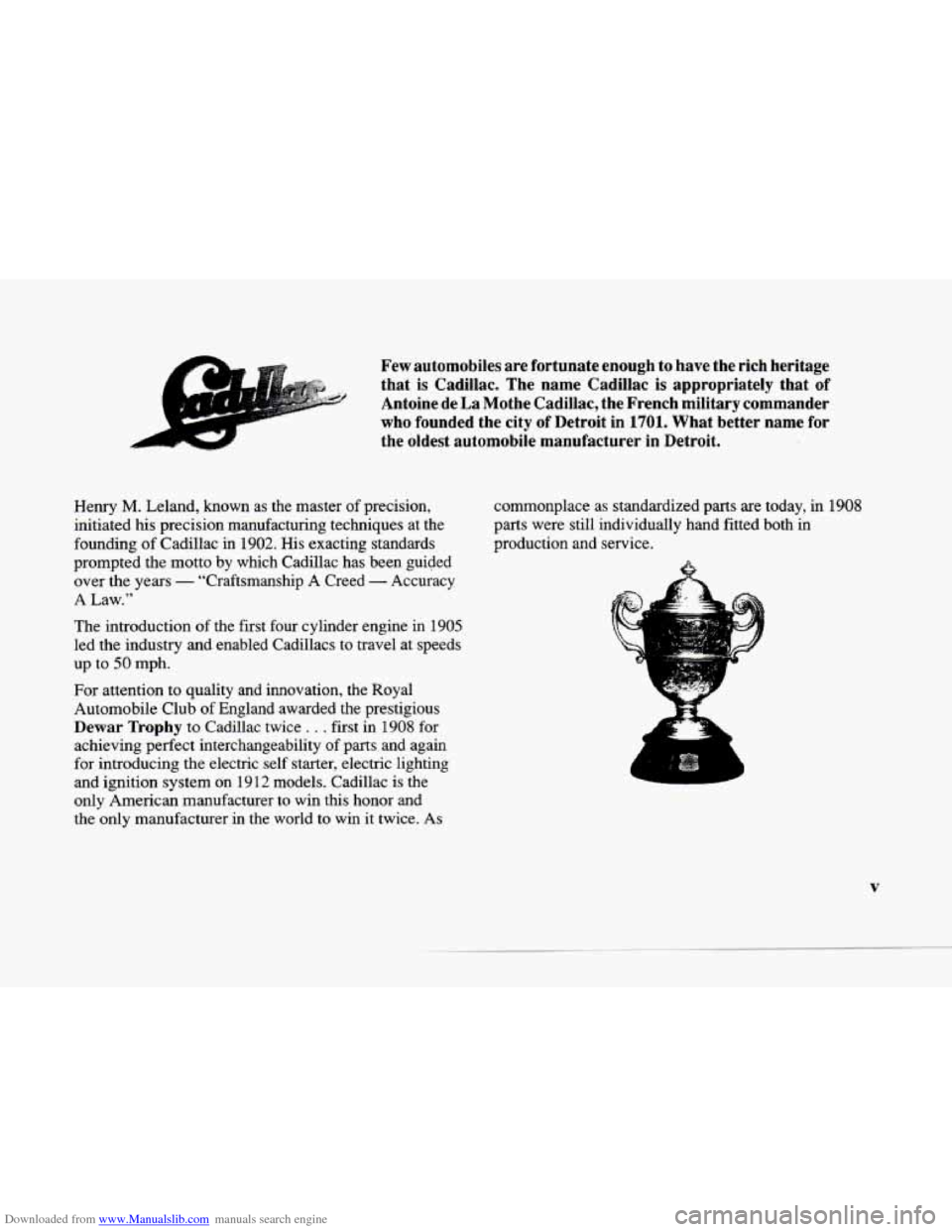
Downloaded from www.Manualslib.com manuals search engine A
k
c
Few automobiles are fortunate enough to have the rich heritage
that is Cadillac. The name Cadillac is appropriately that of
Antoine de La Mothe Cadillac, the French military commander
who founded the city of Detroit in 1701. What better name for
the oldest automobile manufacturer in Detroit.
Henry M. Leland, known as the master of precision,
initiated his precision manufacturing techniques at the
founding of Cadillac in 1902. His exacting standards
prompted the motto
by which Cadillac has been guided
over the years
- “Craftsmanship A Creed - Accuracy
A Law.”
The introduction
of the first four cylinder engine in 1905
led the industry and enabled Cadillacs to travel at speeds
up to
50 mph.
For attention to quality ana Innovation,
the Royal
Automobile Club of England awarded the prestigious
Dewar Trophy to Cadillac twice . . . first in 1908 for
achieving perfect interchangeability of parts and again
for introducing the electric self starter, electric lighting
and ignition system on 191
2 models. Cadillac is the
only American manufacturer to win this honor and
the only manufacturer
in the world to win it twice. As
commonplace as standardized parts are today, in 1908
parts were still individually hand fitted both in
production and service.
V
Page 8 of 354
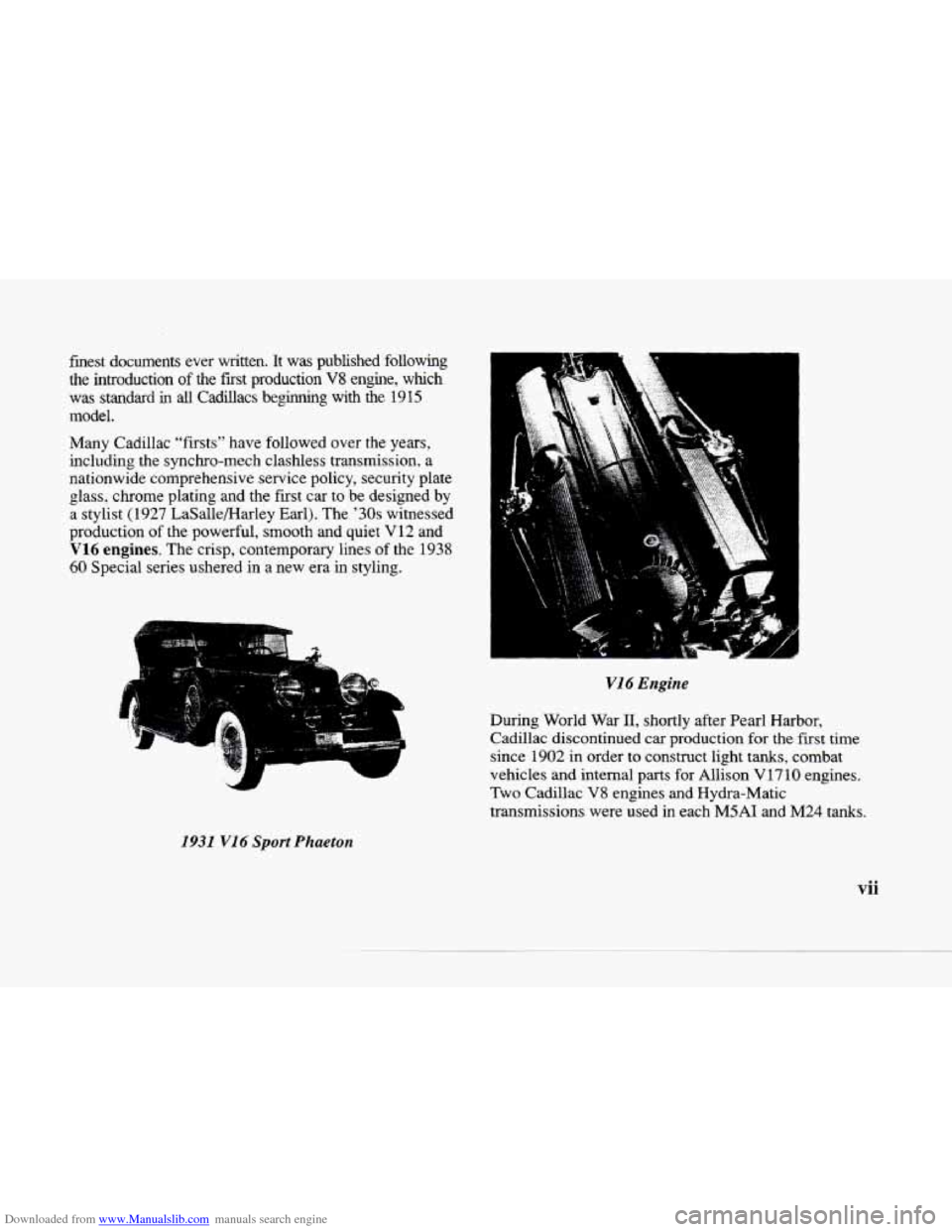
Downloaded from www.Manualslib.com manuals search engine L.
Iy
finest documents ever written. It was published following
the introduction
of the first production V8 engine, which
was standard in all Cadillacs beginning with the 191 5
model. Many Cadillac "firsts" have followed
over the years,
including the synchro-mech clashless transmission. a
nationwide comprehensive service policy, security plate
glass, chrome plating and the first car to be designed by
a stylist
(1927 LaSalle/Harley Earl). The '30s witnessed
production
of the powerful, smooth and quiet V12 and
V16 engines. The crisp, contemporary lines of the 1938
60 Special series ushered in a new era in styling.
4
VI4 Engine
During World War 11, shortly after Pearl Harbor,
Cadillac discontinued car production for
the first time
since 1902 in order to construct light tanks, combat
vehicles and internal
parts for Allison V17 10 engines.
Two Cadillac V8 engines and Hydra-Matic
transmissions were used
in each MSAI and M24 tanks.
1931 VI4 Sport Phaeton
vii
Page 10 of 354
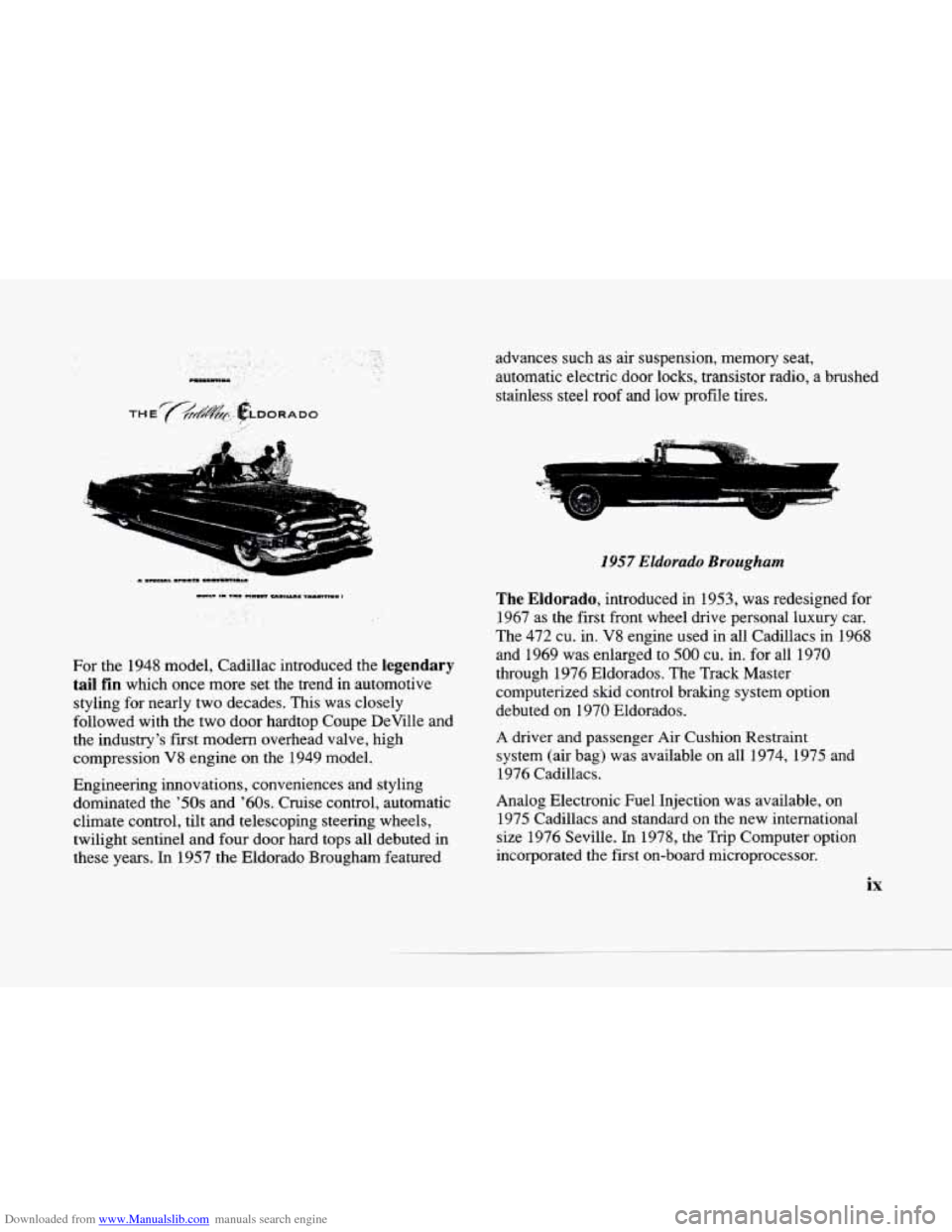
Downloaded from www.Manualslib.com manuals search engine c . . .- . '.
For the 1948 model, Cadillac introduced the legendary
tail fin which once more set the trend in automotive
styling for nearly two decades. This was closely
followed with the two door hardtop Coupe DeVille and
the industry's
first modern overhead valve, high
compression
V8 engine on the 1949 model.
Engineering innovations, conveniences and styling
dominated the
'50s and '60s. Cruise control, automatic
climate control, tilt and telescoping steering wheels,
twilight sentinel and four door hard tops all debuted in
these years. In 1957 the Eldorado Brougham featured advances such
as air suspension,
memory seat,
automatic electric door locks, transistor radio, a brushed
stainless steel roof and low profile tires.
7
1957 Eldorado Brougham
The Eldorado, introduced in 1953, was redesigned for
1967 as the first front wheel drive personal luxury
car.
The 472 cu. in. V8 engine used in all Cadillacs in 1968
and 1969 was enlarged to
500 cu. in. for all 1970
through 1976 Eldorados. The Track Master
computerized skid control braking system option
debuted on 1970 Eldorados.
A driver and passenger Air Cushion Restraint
system (air bag) was available
on all 1974, 1975 and
1976 Cadillacs.
Analog Electronic Fuel Injection was available, on
1975 Cadillacs and standard
on the new international
size 1976 Seville. In 1978, the Trip Computer option
incorporated the first on-board microprocessor.
ix
Page 14 of 354
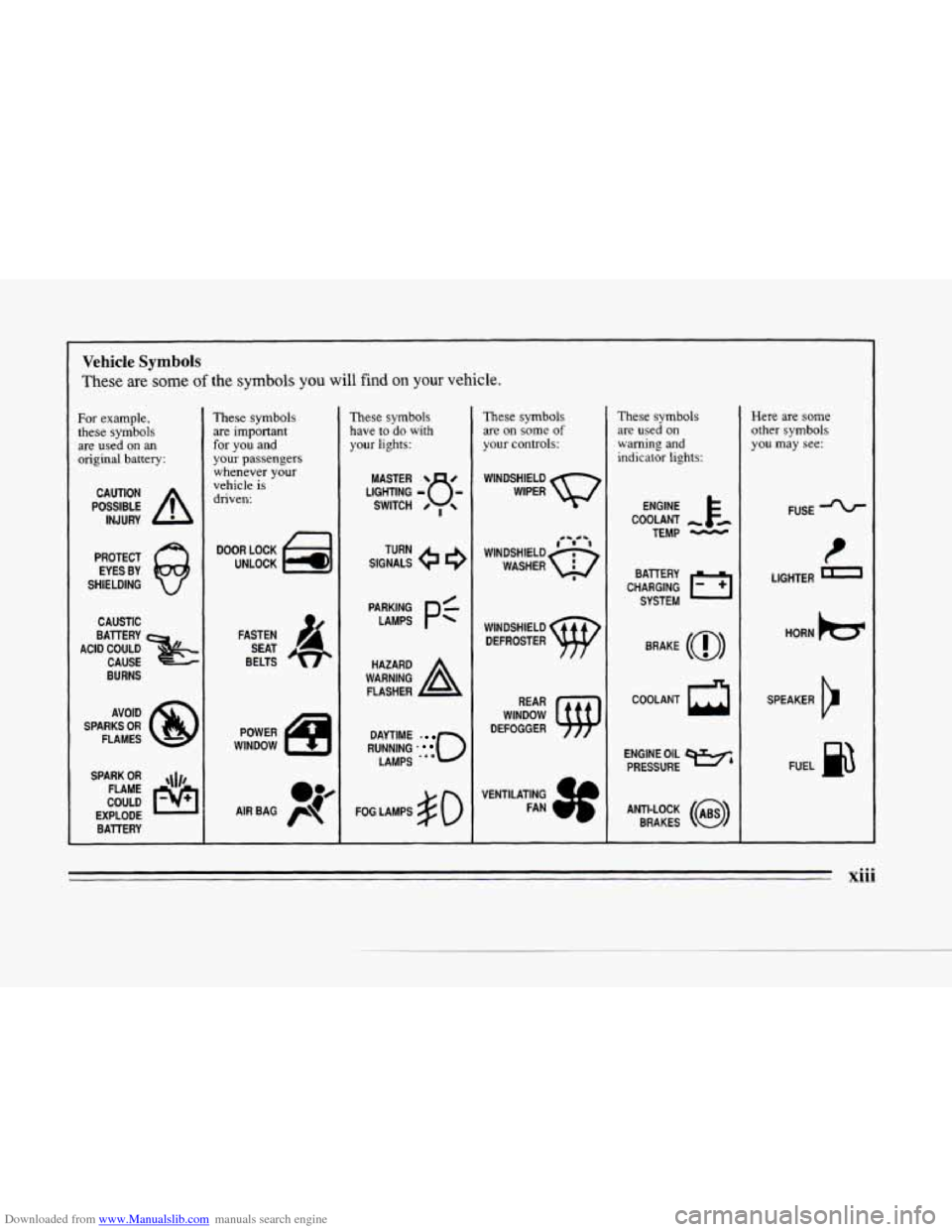
Downloaded from www.Manualslib.com manuals search engine e
e
c
Vehicle Symbols
These are some of the symbols you will find on your vehicle.
For example,
these symbols
are used
on an
original battery:
POSSIBLE A
CAUTION
INJURY
PROTECT
EYES BY
SHIELDING
CAUSTIC
BURNS AVOID
SPARKS
OR
FLAMES
SPARK
OR ,111,
COULD FLAME
EXPLODE BAllERY
These symbols
are important
for you and
your passengers
whenever your
vehicle
is
driven:
DOOR LOCK
UNLOCK
FASTEN SEAT
BELTS
POWER
WINDOW
These symbols have
to do with
your lights:
SIGNALS e
TURN
RUNNING
0
DAYTIME -
LAMPS -**
FOG LAMPS # 0
These symbols are on
some of
your controls:
WINDSHIELD
WIPER
WINDSHIELD DEFROSTER
WINDOW
DEFOGGER
VENTILATING FAN
These symbols
are used on
warning and
indicator lights:
COOLANT -
TEMP -
CHARGING I-1
BATTERY
SYSTEM
BRAKE
(a)
COOLANT a
ENGINE OIL w,
PRESSURE
ANTI-LOCK
(,)
BRAKES
Here are some
other symbols
you may see:
FUSE
LlGl ITER D
HORN k3
SPEAKER
k
FUEL B
xiii
Page 19 of 354
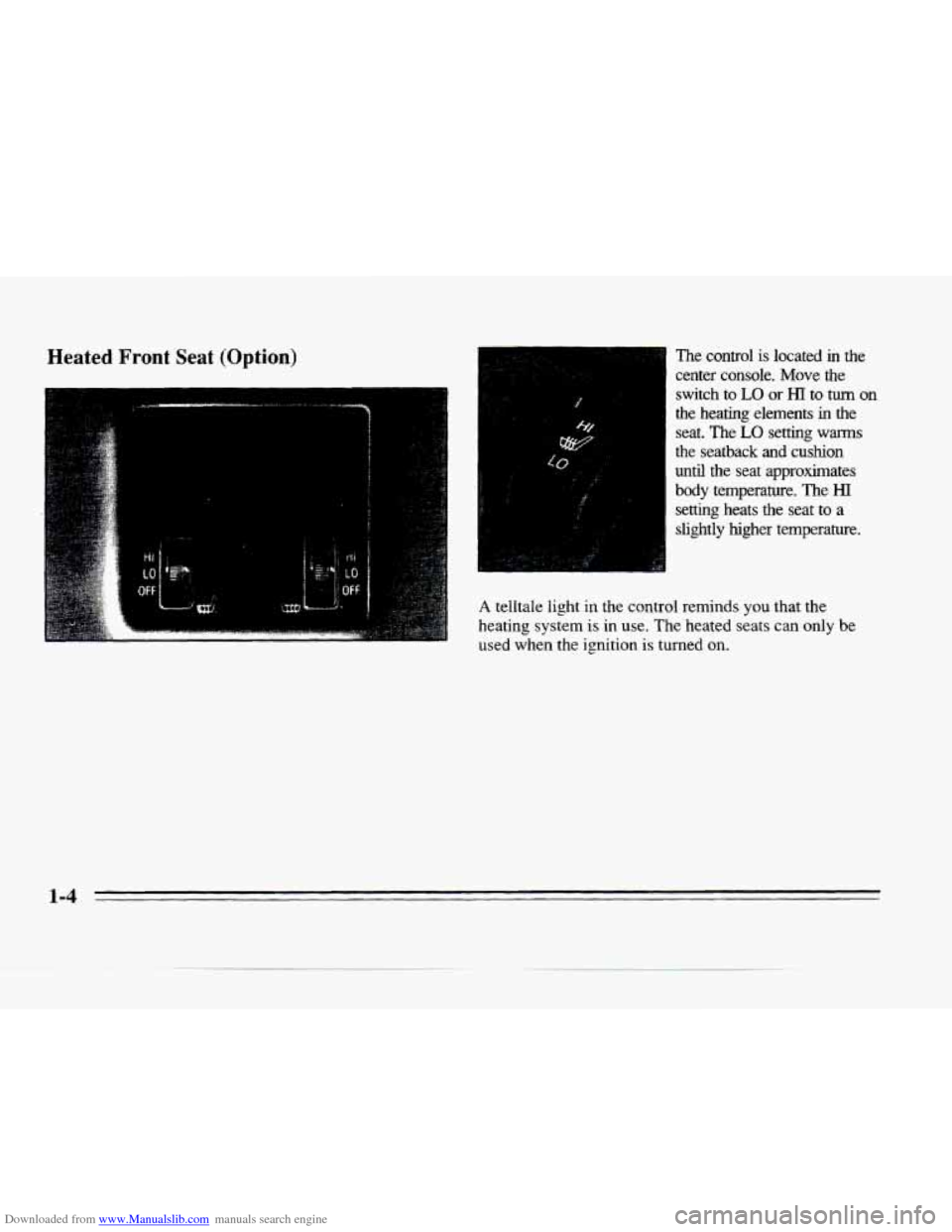
Downloaded from www.Manualslib.com manuals search engine Heated Front Seat (Option)
. .x ,,
The control is located in the
center console. Move the
switch to
LO or HI to turn on
the heating elements in the
seat. The
LO setting warms
the seatback and cushion
until the seat approximates
body temperature. The
HI
setting heats the seat to a
slightly higher temperature.
A telltale light in the control reminds you that the
heating system is in use.
The heated seats can only be
used when the ignition is turned on.
1-4
Page 22 of 354
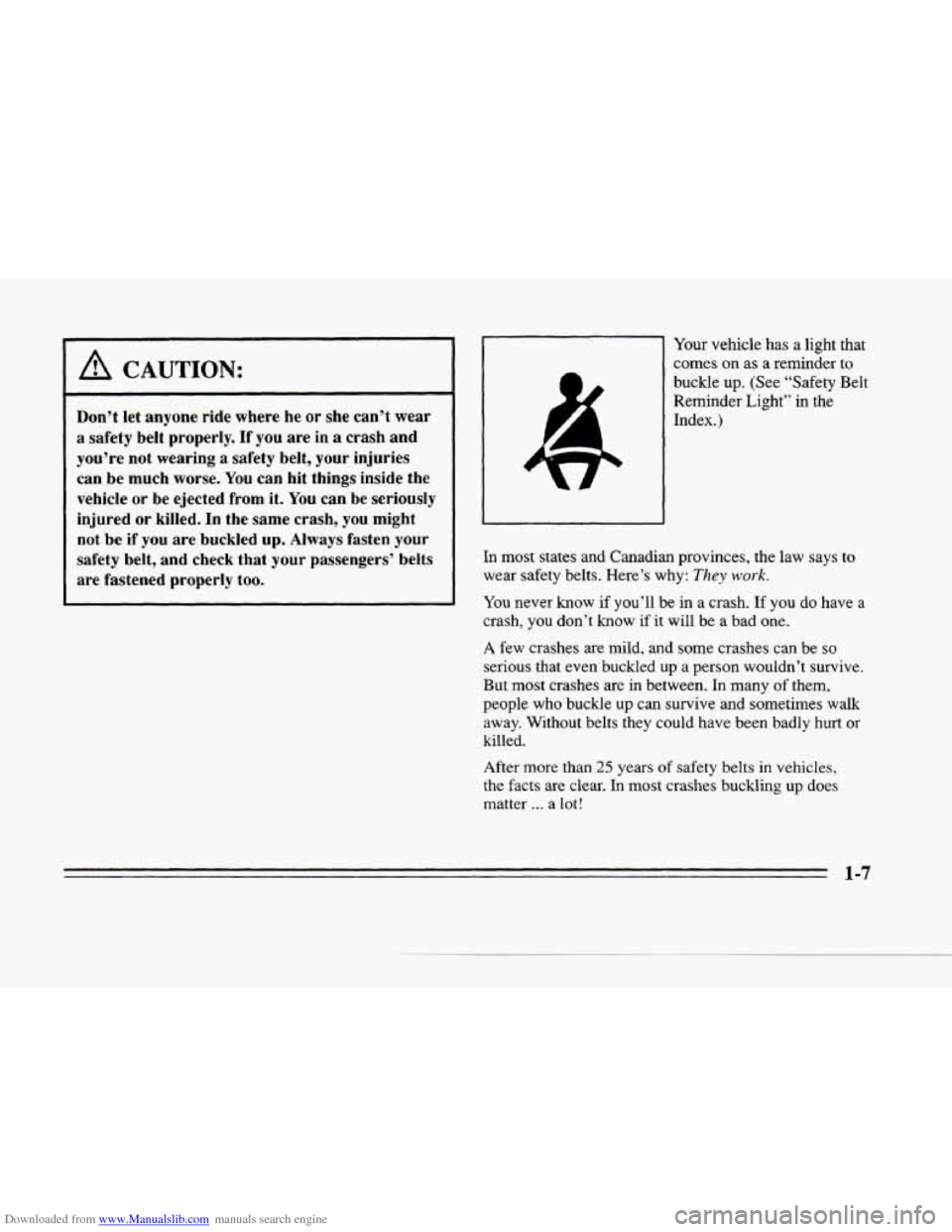
Downloaded from www.Manualslib.com manuals search engine I A CAUTION:
Don’t let anyone ride where he or she can’t wear
a safety belt properly.
If you are in a crash and
you’re not wearing a safety belt, your injuries
can be much worse.
You can hit things inside the
vehicle or be ejected from
it. You can be seriously
injured or killed.
In the same crash, you might
not be
if you are buckled up. Always fasten your
safety belt, and check that your passengers’ belts
are fastened properly too.
Your vehicle has a light that
comes on
as a reminder to
buckle up. (See “Safety Belt
Reminder Light” in
the
Index.)
In most states and Canadian provinces, the law says to
wear safety belts. Here’s why:
They work.
You never know if you’ll be in a crash. If you do have a
crash, you don’t know if it will be a bad one.
A few crashes are mild, and some crashes can be so
serious that even buckled up a person wouldn’t survive.
But most crashes are in between. In many
of them,
people
who buckle up can survive and sometimes walk
away. Without belts they could have been badly hurt or
killed.
After more than
25 years of safety belts in vehicles,
the facts are clear.
In most crashes buckling up does
matter ... a lot!
Page 30 of 354
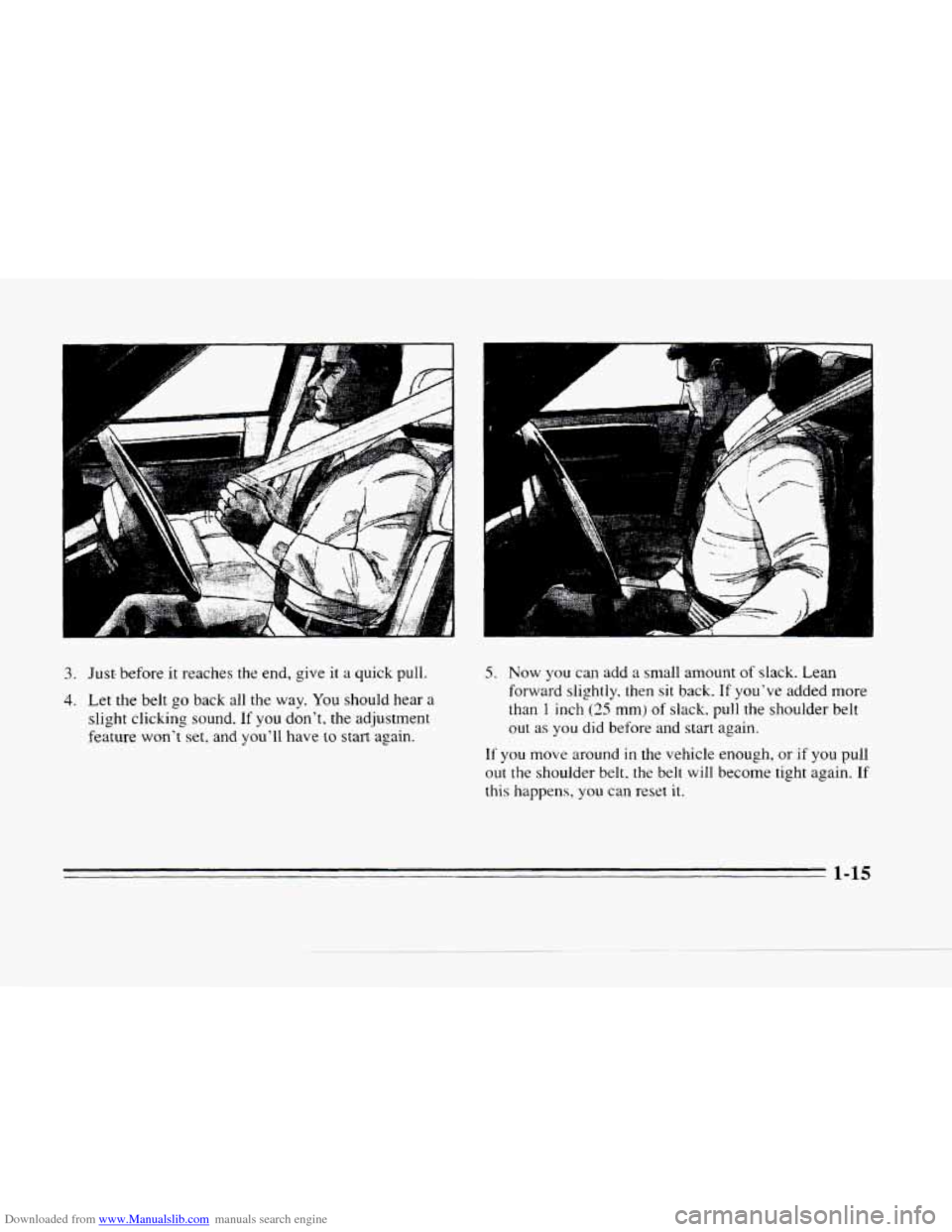
Downloaded from www.Manualslib.com manuals search engine 4
- 1c . I
/-
3. Just, before it reaches the end, give it a quick pull.
4. Let the belt go back all the way. You should hear a
slight clicking sound.
If you don’t, the adjustment
feature won‘t set, and you’ll have
to start again.
5. Now you can add a small amount of slack. Lean
forward slightly,
then sit back. If you’ve added more
than
1 inch (25 mm) of slack, pull the shoulder belt
out as you did before and start again.
If you move around in the vehicle enough, or if you pull
out the shoulder belt. the belt will become tight again.
If
this happens, you can reset it.
1-15
Page 36 of 354
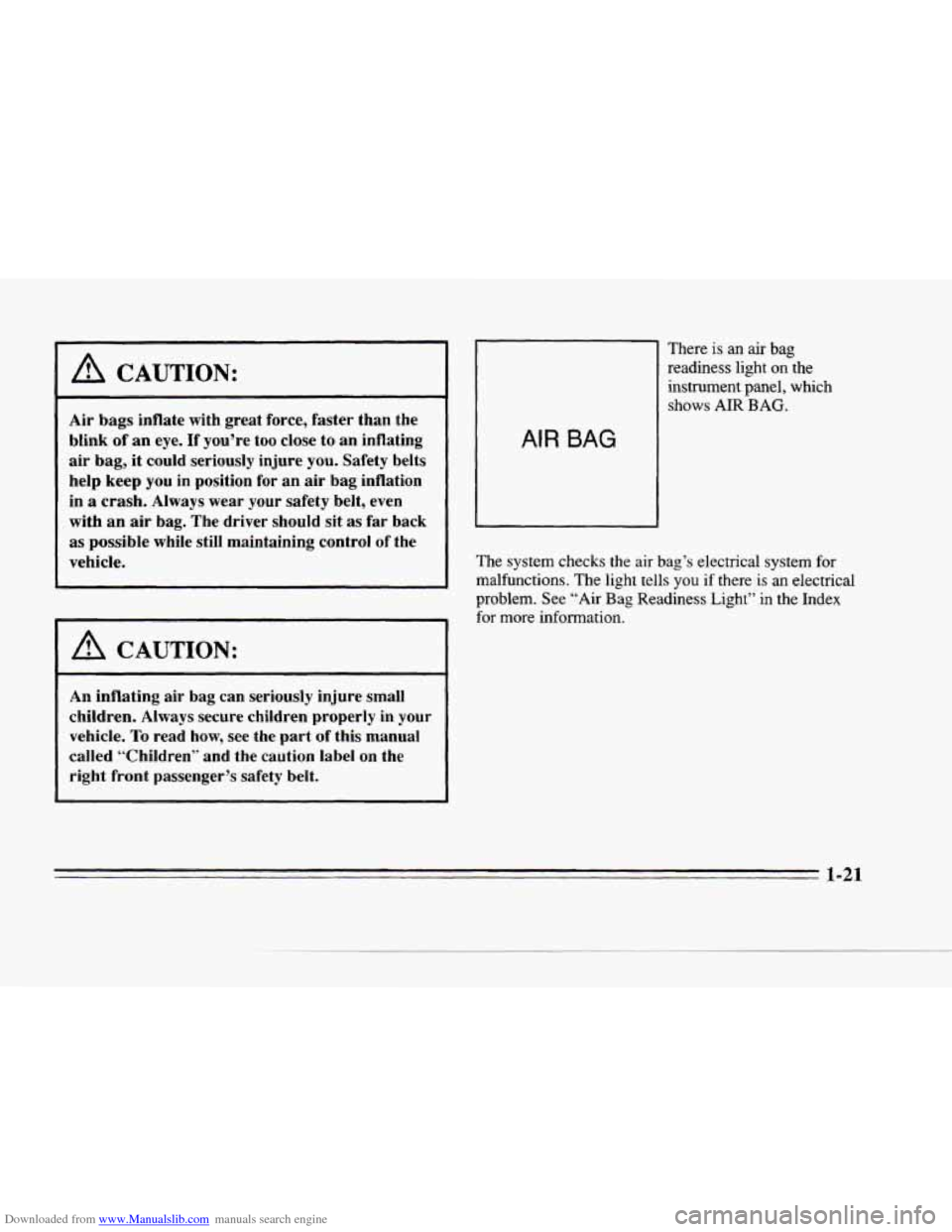
Downloaded from www.Manualslib.com manuals search engine c
c
A CAUTION:
Air bags inflate with great force, faster than the
blink of an eye.
If you’re too close to an inflating
air bag, it could seriously injure you. Safety belts
help keep you
in position for an air bag inflation
in
a crash. Always wear your safety belt, even
with an
air bag. The driver should sit as far back
as possible while still maintaining control of the
vehicle.
I A CAUTION:
An inflating air bag can seriously injure small
children. Always secure children properly
in your
vehicle.
To read how, see the part of this manual
called “Children” and the caution label on the
right front passenger’s safety belt.
11 There is an air bag
AIR BAG
readiness light on the
instrument panel, which
shows AIR
BAG.
The system checks the air bag’s electrical system for
malfunctions. The light tells
you if there is an electrical
problem. See
“Air Bag Readiness Light” in the Index
for more information.
1 31
Page 42 of 354
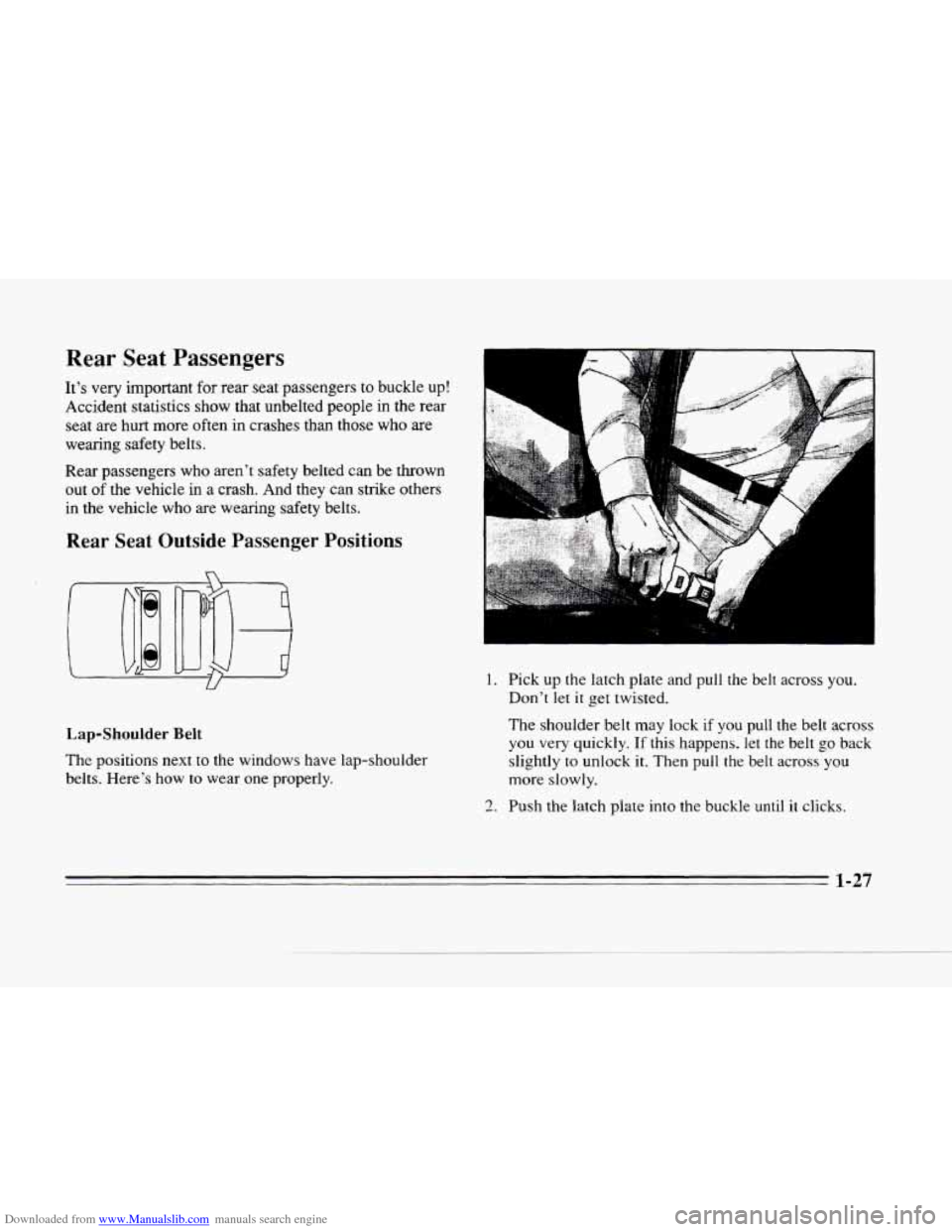
Downloaded from www.Manualslib.com manuals search engine c
Rear Seat Passengers
It’s very important for rear seat passengers to buckle up!
Accident statistics show that unbelted people
in the rear
seat
are hurt more often in crashes than those who are
wearing safety belts.
Rear passengers who aren’t safety belted can be thrown
out
of the vehicle in a crash. And they can strike others
in the vehicle who are wearing safety belts.
Rear Seat Outside Passenger Positions
i3
Lap-Shoulder Belt
The positions next to the windows have lap-shoulder
belts. Here’s how to wear one properly.
1. Pick up the latch plate and pull the belt across you.
Don’t let
it get twisted.
The shoulder belt may lock if you pull the belt across
you very quickly.
If this happens. let the belt go back
slightly to unlock it. Then pull the belt across you
more slowly.
2. Push the latch plate into the buckle until it clicks.
1-27
Page 59 of 354
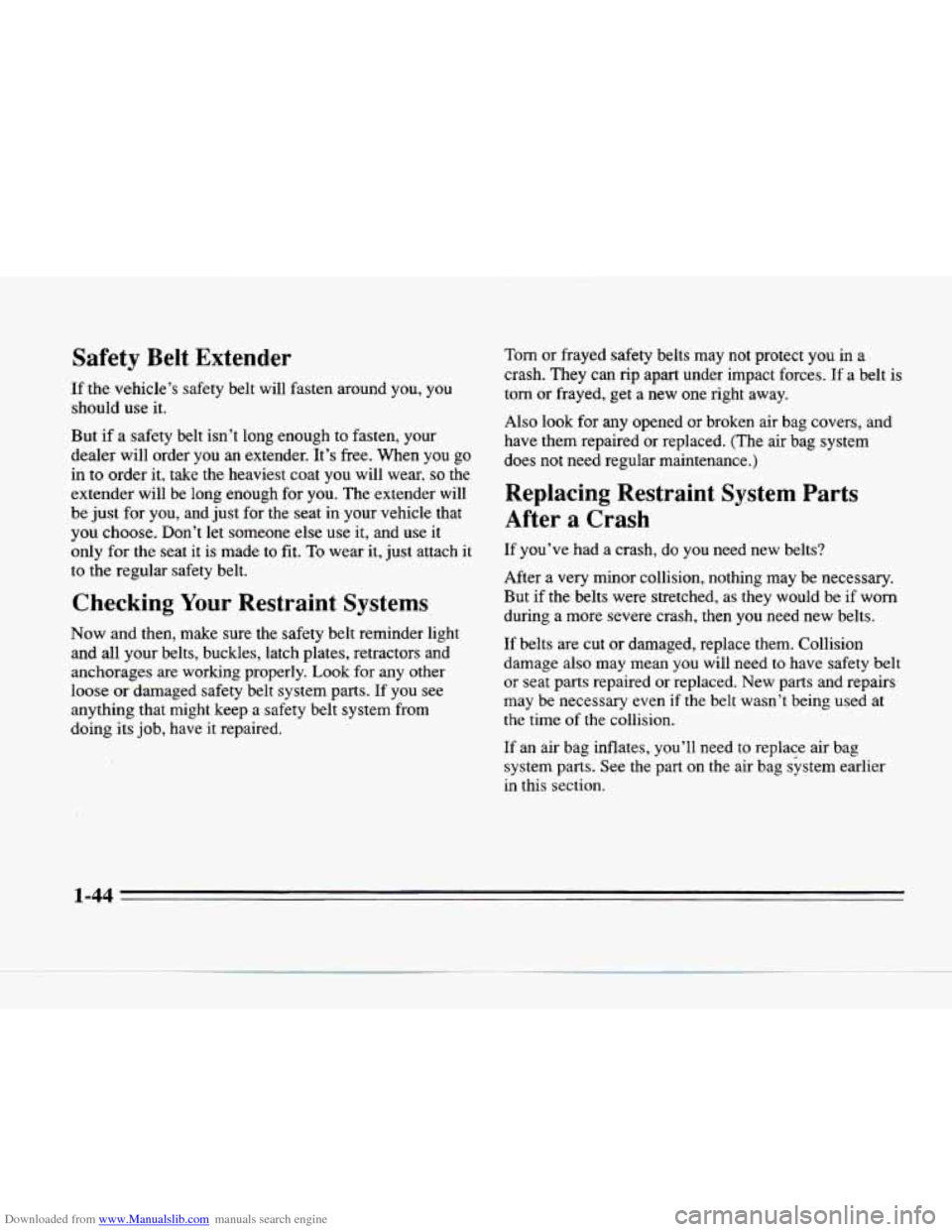
Downloaded from www.Manualslib.com manuals search engine Safety Belt Extender
If the vehicle’s safety belt will fasten around you, you
should use it.
But if a safety belt isn’t long enough to fasten, your
dealer will order
you an extender. It’s free. When you go
in to order it, take the heaviest coat you will wear, so the
extender will be long enough for you. The extender will
be just for you, and
just for the seat in your vehicle that
you choose. Don’t let someone
else use it, and use it
only for the seat it is made to fit. To wear it, just attach it
to the regular safety belt.
Checking Your Restraint Systems
Now and then, make sure the safety belt reminder light
and
all your belts, buckles, latch plates, retractors and
anchorages are working properly. Look for any other
loose
or damaged safety belt system parts. If you see
anything that might keep a safety belt system from
doing its job, have
it repaired.
Torn or frayed safety belts may not protect you in a
crash. They can rip apart under impact forces. If a belt
is
tom or frayed, get a new one right away.
Also look for any opened
or broken air bag covers, and
have them repaired or replaced. (The air bag system
does not need regular maintenance.)
Replacing Restraint System Parts
After
a Crash
If you’ve had a crash, do you need new belts?
After a very minor collision, nothing may be necessary. But if the belts were stretched, as they would be if
worn
during a more severe crash, then you need new belts.
If belts are cut or damaged, replace them. Collision
damage also may mean
you will need to have safety belt
or seat parts repaired or replaced. New parts and repairs
may be necessary even
if the belt wasn’t being used at
the time of the collision.
If an air bag inflates, you’ll need
to replace air bag
system parts. See the
part on the air bag system earlier
in this section.
1-44